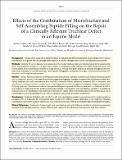| dc.contributor.author | Barrett, M. F. | |
| dc.contributor.author | Werpy, N. M. | |
| dc.contributor.author | McIlwraith, C. Wayne | |
| dc.contributor.author | Frisbie, David D. | |
| dc.contributor.author | Grodzinsky, Alan J. | |
| dc.contributor.author | Hung, Han-Hwa K. | |
| dc.contributor.author | Frank, Eliot | |
| dc.contributor.author | Miller, Rachel Elizabeth | |
| dc.date.accessioned | 2014-10-14T19:46:13Z | |
| dc.date.available | 2014-10-14T19:46:13Z | |
| dc.date.issued | 2014-10 | |
| dc.identifier.issn | 0021-9355 | |
| dc.identifier.issn | 1535-1386 | |
| dc.identifier.uri | http://hdl.handle.net/1721.1/90920 | |
| dc.description.abstract | Background: The goal of this study was to test the ability of an injectable self-assembling peptide (KLD) hydrogel, with or without microfracture, to augment articular cartilage defect repair in an equine cartilage defect model involving strenuous exercise.
Methods: Defects 15 mm in diameter were created on the medial trochlear ridge and debrided down to the subchondral bone. Four treatment groups (n = 8 each) were tested: no treatment (empty defect), only defect filling with KLD, only microfracture, and microfracture followed by filling with KLD. Horses were given strenuous exercise throughout the one-year study. Evaluations included lameness, arthroscopy, radiography, and gross, histologic, immunohistochemical, biochemical, and biomechanical analyses.
Results: Overall, KLD-only treatment of defects provided improvement in clinical symptoms and improved filling compared with no treatment, and KLD-only treatment protected against radiographic changes compared with microfracture treatment. Defect treatment with only microfracture also resulted in improved clinical symptoms compared with no treatment, and microfracture treatment resulted in repair tissue containing greater amounts of aggrecan and type-II collagen compared with KLD-only treatment. Microfracture treatment also protected against synovial fibrosis compared with no treatment and KLD-only treatment. Treatment with the self-assembling KLD peptide in combination with microfracture resulted in no additional improvements over microfracture-only treatment. In general, the nature of the predominant tissue in the defects was a mix of noncartilaginous and fibrocartilage tissue, with no significant differences among the treatments.
Conclusions: Treatment of defects with only KLD or with only microfracture resulted in an improvement in clinical symptoms compared with no treatment; the improvement likely resulted from different causes depending on the treatment. Whereas microfracture improved the quality of repair tissue, KLD improved the amount of filling and protected against radiographic changes.
Clinical Relevance: Treatment of defects with only microfracture and with KLD only resulted in clinical improvements compared with untreated defects, despite differing with respect to the structural improvements that they induced. | en_US |
| dc.language.iso | en_US | |
| dc.publisher | Journal of Bone and Joint Surgery, Inc | en_US |
| dc.relation.isversionof | http://dx.doi.org/10.2106/jbjs.m.01408 | en_US |
| dc.rights | Article is made available in accordance with the publisher's policy and may be subject to US copyright law. Please refer to the publisher's site for terms of use. | en_US |
| dc.source | Journal of Bone and Joint Surgery, Inc. | en_US |
| dc.title | Effects of the Combination of Microfracture and Self-Assembling Peptide Filling on the Repair of a Clinically Relevant Trochlear Defect in an Equine Model | en_US |
| dc.type | Article | en_US |
| dc.identifier.citation | Miller, R. E., A. J. Grodzinsky, M. F. Barrett, H.-H. Hung, E. H. Frank, N. M. Werpy, C. W. McIlwraith, and D. D. Frisbie. “Effects of the Combination of Microfracture and Self-Assembling Peptide Filling on the Repair of a Clinically Relevant Trochlear Defect in an Equine Model.” The Journal of Bone & Joint Surgery 96, no. 19 (October 1, 2014): 1601–1609. © 2014 by The Journal of Bone and Joint Surgery, Incorporated | en_US |
| dc.contributor.department | Massachusetts Institute of Technology. Department of Biological Engineering | en_US |
| dc.contributor.mitauthor | Grodzinsky, Alan J. | en_US |
| dc.contributor.mitauthor | Hung, Han-Hwa K. | en_US |
| dc.contributor.mitauthor | Frank, Eliot | en_US |
| dc.contributor.mitauthor | Miller, Rachel Elizabeth | en_US |
| dc.relation.journal | The Journal of Bone & Joint Surgery | en_US |
| dc.eprint.version | Final published version | en_US |
| dc.type.uri | http://purl.org/eprint/type/JournalArticle | en_US |
| eprint.status | http://purl.org/eprint/status/PeerReviewed | en_US |
| dspace.orderedauthors | Miller, R. E.; Grodzinsky, A. J.; Barrett, M. F.; Hung, H.-H.; Frank, E. H.; Werpy, N. M.; McIlwraith, C. W.; Frisbie, D. D. | en_US |
| dc.identifier.orcid | https://orcid.org/0000-0002-8911-7998 | |
| dc.identifier.orcid | https://orcid.org/0000-0002-4942-3456 | |
| mit.license | PUBLISHER_POLICY | en_US |
| mit.metadata.status | Complete | |
